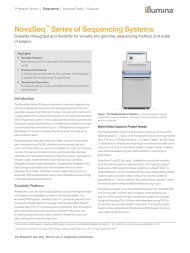Abstracts
ngsfinalprogram
ngsfinalprogram
Create successful ePaper yourself
Turn your PDF publications into a flip-book with our unique Google optimized e-Paper software.
Poster <strong>Abstracts</strong><br />
resources leading to more effective epidemiologic<br />
field investigations and an improved<br />
ability to identify where public health intervention<br />
will have the greatest impact. This curated<br />
data set can be used to evaluate bioinformatic<br />
pipelines for variant detection using whole<br />
genome SNP or multi-locus sequence typing<br />
(wgMLST) platforms.<br />
n 86<br />
RAPID WHOLE GENOME SEQUENCING<br />
AND DE NOVO ASSEMBLY PIPELINE FOR<br />
BORDETELLA PERTUSSIS USING MULTIPLE<br />
PLATFORMS<br />
Y. Peng, M. M. Williams, M. R. Weigand, K.<br />
Bowden, M. L. Tondella;<br />
Centers for Disease Control and Prevention,<br />
Atlanta, GA.<br />
In the U.S. and many other developed countries,<br />
pertussis is currently the least well controlled<br />
vaccine‐preventable bacterial disease<br />
despite excellent vaccination coverage. Whole<br />
genome sequences of Bordetella pertussis, the<br />
causative agent of pertussis disease, will help<br />
us better understand the epidemiologic and<br />
clinical relevance of current circulating strains,<br />
develop novel diagnostic assays, and elucidate<br />
the possible reasons for the current increase<br />
in pertussis in the U.S. and around the world.<br />
However, with hundreds of insertion sequences,<br />
repeat regions, and large rearrangements<br />
in the B. pertussis genome, whole-genome<br />
sequencing and assembly is challenging. There<br />
are currently over 400 B. pertussis incomplete<br />
genome assemblies publically available,<br />
most of them are composed of over hundreds<br />
contigs assembled from short read sequencing.<br />
Our group has developed a rapid whole<br />
genome sequencing and assembly pipeline for<br />
B. pertussis by taking advantage of the latest<br />
long read PacBio RSII sequencing platform;<br />
highly accurate, high coverage and low cost<br />
Illumina sequencing platforms; and the OpGen<br />
genome optical mapping system. High quality<br />
genomic DNA was isolated with the Qiagen<br />
Puregene Yeast/Bact. Kit. Utilizing P6 PacBio<br />
chemistry and 240 minutes movie recording,<br />
one SMRT cell produced over 50 X coverage<br />
subreads with N 50<br />
as high as 13 kb, which was<br />
able to assemble into one complete genome using<br />
HGAP 3.0. After removing the end overlap<br />
to close the circular genome, the structure of<br />
de novo assemblies was further tested and confirmed<br />
by optical mapping and finally polished<br />
by mapping with high quality short Illumina<br />
reads. So far, nearly 200 genomes have been<br />
completed using this multi-platform pipeline<br />
and sequencing of more than 200 additional<br />
isolates is currently underway. Deep genome<br />
variation analysis (SNPs, rearrangements and<br />
IS-elements, etc.) will direct future work with<br />
other ‘omics’ approaches, including RNASeq<br />
and peptide profiling, to determine causes for<br />
pertussis increase.<br />
n 87<br />
DEVELOPMENT OF A SUBTYPING ASSAY<br />
FOR DIRECT DETECTION AND TARGETED<br />
SEQUENCING OF SHIGA TOXIN-PRODUCING<br />
ESCHERICHIA COLI (STEC) FROM CLINICAL<br />
SAMPLES<br />
L. M. Gladney 1 , D. Fasulo 2 , R. L. Lindsey 1 , A.<br />
Huang 1 , E. Trees 1 , N. Strockbine 1 , E. R. Ribot 1 ,<br />
H. A. Carleton 1 , J. Besser 1 ;<br />
1<br />
Centers for Disease Control, Atlanta, GA,<br />
2<br />
Pattern Genomics, LLC, Madison, CT.<br />
Shiga toxin-producing Escherichia coli<br />
(STEC) is an important foodborne pathogen<br />
that causes approximately 265,000 infections<br />
and nearly 30 outbreaks per year in the US.<br />
STEC has been traditionally diagnosed by<br />
culture and subtyped using a variety of methods<br />
to help detect outbreaks. Recently, cultureindependent<br />
diagnostic tests (CIDTs) have<br />
been introduced in many clinical labs in place<br />
of culture-based methods. These methods are<br />
attractive because they are cost-effective, can<br />
be performed at point-of-care, and do not require<br />
culture of the pathogen. As a result, the<br />
current laboratory-based surveillance system<br />
in the US, PulseNet, is threatened because it<br />
relies on pure cultures to perform subtyping by<br />
98<br />
ASM Conferences



